
View of the Funeral Car Containing the Remains of President Lincoln
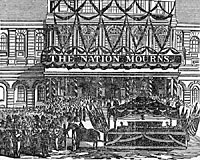
View of City Hall, with hearse bearing the remains of President Lincoln

President Lincoln’s Railroad Funeral Car
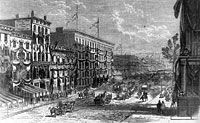
Mourning in New York City

Arrival of Casket at City Hall
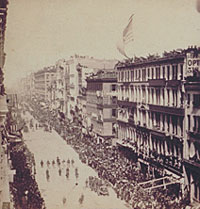
Lincoln’s Funeral Procession, New York, April 25th, 1865
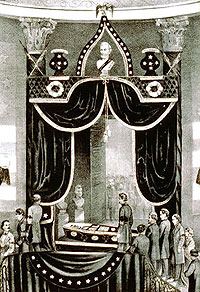
The body of the Martyr President, Abraham Lincoln: Lying in State at the city hall, N.Y.
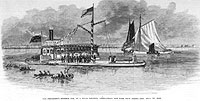
The President’s funeral car, on a steam lighter, approaching New York
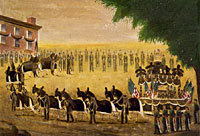
Lincoln’s Funeral Train, April 26, 1865
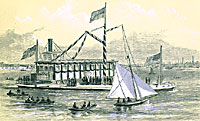
Funeral Car Crossing Hudson River
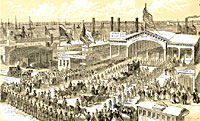
Arrival of the Remains at Debrosses Street Ferry
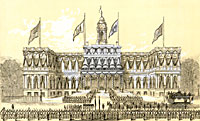
View of the City Hall
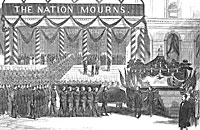
President Lincoln’s Funeral – Removal of the Body from the City Hall to the Funeral Car, New York, April 25, 1865
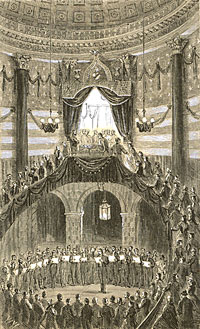
Dome of the City Hall, Scene at Midnight
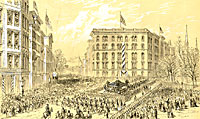
Procession Passing Fifth Avenue Hotel
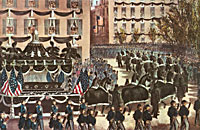
Lincoln’s Funeral Procession
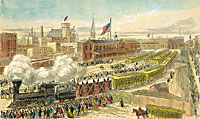
Departure of the Remains
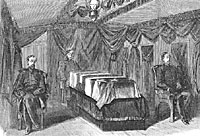
Interior of the President’s Funeral Car, with the Coffin and Guard of Honor
The grieving in New York City for President Lincoln began immediately on the day of his death, April 15, 1865. Crepe sprung from windows all across the city. Citizens gathered on Wall and Broad Streets in downtown. There was a mass meeting at the New York City Customs House where Maine Senator William P. Fessenden, former New York Senator Daniel L. Dickinson, and Generals Benjamin Butler and James Garfield spoke. Attorney George Templeton Strong wrote in diary: “What a day it has been! Excitement and suspension of business even more general than on the 3rd instant. Tone of feeling very like that of four years ago when the news came of Sumter. This atrocity has invigorated national feeling in the same way, almost in the same degree. People who pitied our misguided brethren yesterday.”1
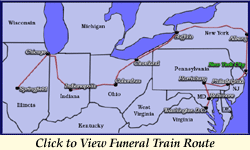
The outpouring impressed many war-weary observers. “Lincoln’s death — thousands of flags at half mast — & on numbers of them long back pennants — from the shipping densely crowding the docks, the same — numerous ferry boats constantly plying across the river, the same solemn signal — black — business public & private all suspended, & the shops closed — strange mixture of horror, fury, tenderness, & a stirring wonder brewing,” wrote poet Walt Whitman, who had frequently observed President Lincoln from a distance when they both lived in Washington, D.C..
2
Whitman described New York City the morning after his assassination: “In the forenoon, the news had not more than been rec’d. All Broadway is black with mourning — the facades of the houses are festooned with black — great flags with wide & heavy fringes of dead black, give a pensive effect — towards noon the sky darkened & it began to rain. Drip, drip, & heavy moist black weather — the stores are all closed — the rain sent the women from the street & black clothed men only remained — black clouds driving overhead — the horror, fever, uncertainty, alarm in the public — Every hour brings a great history event on the wires — at 11 o’clock the new president is sworn — at 4 the murder is- ” Continued Whitman: “Lincoln’s death — black, black, black — as you look toward the sky — long broad black like great serpents slowly undulating in every direction — New York is distinguished for its countless gay flags — every house seems to have a flag staff — on all these the colors were at half mast.”3
Attorney George Templeton Strong wrote in his diary: “The temper of the great meeting I found assembled in front of the Custom House (the old Exchange) was grim. A Southerner would compare it with that of the first session of the Jacobins after Marat’s death. I thought it healthy and virile. It was the first great patriotic meeting since the war began at which there was no talk of concession and conciliation. It would have endured no such talk. Its sentiments seemed like this: ‘Now it is plain at last to everybody that there can be no terms with the woman-flogging aristocracy. Grant’s generous dealing with Lee was a blunder. The Tribune‘s talk for the last fortnight was folly. Let us henceforth deal with rebels as they deserve. The rose-water treatment does not meet their case.’ I have heard it said fifty times today: ‘These madmen have murdered the two best friends they had in the world!’ I heard of three or four men in Wall Street and near the Post Office who spoke lightly of the tragedy, and were instantly set up by the bystanders and pummelled. One of them narrowly escaped death.”4
New York Secretary of State Chauncey M. Depew recalled: “I never can forget when the news of Lincoln’s assassination reached New York. The angry and dangerous crowd which surged up and down Broadway and through Wall Street threatened to wreck the banking and business houses which were supposed to be sympathetic with the Confederates. [Future President James A.] Garfield suddenly appeared on the balcony of the custom House in Wall Street and succeeded in stilling the crowd. With a voice that reached up to Trinity Church he urged calmness in thought and action, deprecated any violence, and then, in an impassioned appeal to hopefulness notwithstanding the tragedy, exclaimed impulsively: ‘God reigns and the Republic still lives.'”5
New Yorkers turned out in force for religious remembrances of the late President — including one at the 19th Street Synagogue where the rabbi led the congregation in the prayer for the dead. George Templeton Strong described New York City on the day after President Lincoln’s death: “An Easter Sunday unlike any I have seen. Drove downtown very early with Ellie, Johnny, and Temple. Nearly every building in Broadway and in all the side streets, as far as one could see, festooned lavishly with black and white muslin. Columns swathed in the same material. Rosettes pinned to window curtains. Flags at half mast and tied up with crape. I hear that even in second and third class quarters, people who could afford to do no more have generally displayed at least a little twenty-five cent flag with a little scrap of crape.”6
Diarist Strong reported on Monday: “All over the city, people have been at work all day, draping street fronts, so that hardly a building on Wall Street, Broadway, Chambers Street, Bowery, Fourth Avenue is without its symbol of the profound public sorrow. What a place this man, whom his friends have been patronizing for four years as a well-meaning, sagacious, kind-hearted, ignorant, old codger, had won for himself in the hearts of the people! What a place he will fill in history! I foresaw most clearly that he would be ranked high as the Great Emancipator twenty years hence, but I did not suppose his death would instantly reveal — even to Copperhead newspaper editors — the nobleness and the glory of his part in this great contest. It reminds one of the last line of Blanco White’s great sonnet, ‘If Light can thus deceive, where not Life?’ Death has suddenly opened the eyes of the people (and I think of the word) to the fact that a hero has been holding high place among them for four years, closely watched and studied, but despite and rejected by a third of this community, and only tolerated by the other two-thirds.”7
Funeral activities in Washington lasted until Thursday, April 20. The next day, President Lincoln’s body left for its long trip home. It wasn’t until nine days after President Lincoln’s death that the funeral train carrying his body back to Springfield reached New York City. “The reception in New York was worthy alike of the great city and of the memory of the man they honored,” wrote presidential aide John G. Nicolay, who accompanied his murdered boss back to Springfield.8
White House doorman Thomas Pendel also accompanied the funeral train: “We left Philadelphia for New York, and arrived at quite an early hour. Here the throngs of people were immense, and the police had all they could do to keep the great mass back, so that the procession could pass up to the City Hall, where the remains were laid in state. The decorations in New York City were something wonderful, particularly on Broadway and Fifth Avenue, where they were of the finest materials.”9 Aboard the train were many of the President’s friends and aides — including General David Hunter, Supreme Court Justice David Davis, U.S. Marshal Ward Hill Lamon and presidential aides John Hay and John G. Nicolay — all of whom had accompanied the pre-inaugural train from Springfield to Washington in 1861. The coffin was carried by the ferryboat Jersey City across New York harbor on April 24. New York Times editor Henry J. Raymond wrote:
At four o’clock, on the morning of the 24th of April, the funeral train took its departure for New York. Marching in solemn sate through the crowds of people, which seemed to line the track all along the route, it reached Jersey City, opposite New York, and passed into the spacious depot, which had been clad in mourning, to the music of a funeral dirge, executed by a choir of seventy singers, and under the roar of heavy and loud artillery. The coffin was lifted from the car and borne on the shoulders of ten stalwart veterans followed by a procession of conspicuous officials, marching to the music of ‘Rest in the Grave,’ sung by the choral societies, to the hearse prepared for its reception.10
According to biographer Carl Sandburg wrote: “Chauncey M. Depew, secretary of state for New York, in behalf of the unavoidably absent Governor Reuben E. Fenton, for the Empire State formally received the body from Governor [Joel] Parker of New Jersey. Ten stalwart sergeants carried the casket to a hearse which moved through street crowds to the ferry house. The paint was fresh on a legend here reading ‘George Washington, the Father: Abraham Lincoln, the Saviour, of His Country.’ The ferryboat Jersey City moved across the Hudson River, her pilothouse and cabins in scrape, flags at half-mast. As she neared the wharf at Desbrosses Street, the German choral society gave a funeral ode from the first book of Horace.”11 Also aboard the ferryboat were Mayor C. Godfrey Gunther and leaders of the City Council.
The arrival of the martyred President’s body in New York City was met with profound respect. “Perhaps it was the unusual scene enacted before them; perhaps it was the touching requiem being sung; or perhaps it was the sudden guns that prompted every man to bare his head as if obeying an order,” wrote Victor Searcher in Farewell to Lincoln. “Ladies burst into tears. A few boys, entranced by the otherworldly proceedings, failed to remove their caps, and received an unexpected punch in the nose for their lack of manners.”12
The New York Times‘ Henry J. Raymond wrote that “the hearse, drawn by six gray horses, heavily draped in black, took its place in the procession, headed by General [John A.] Dix and other officers, escorted by the Seventh Regiment, and the whole cortege moved, through densely crowded streets and amidst the most impressive display of public and private grief, to the City Hall.”13 The glass hearse itself was festooned with eight plumes of white and black feathers. It followed along Desbrosses Street to Canal Street, where it turned down Broadway to City Hall. Historian Victor Searcher noted that “Nearly everyone exhibited some emblem of respect and grief; either a band of black crape around the upper left sleeve or hat, or a special mourning badge such as were being sold by street vendors.”14
Lincoln chronicler Lloyd Lewis wrote: “It was the greatest sight New York had even seen: one hundred and sixty thousand persons, most of them in organized groups, marched in the parade, each group vying with the others for the happiest manifestation of woe. Cleverness collaborated with invention to devise spectacular floats, impressive mottoes, lavish effects. Lodges, labor unions, commercial bodies, sought to outdo each other like so many Mardi Gras clubs or ‘mummers’ societies.'” Lewis wrote of the procession which included about 20 bands:
The New York Caulkers Association, one thousand strong, bore an obelisk with the motto “The Darkest Hour in History.” Longshoreman’s Union No. 2 carried a mammoth sign “In Memory of departed Worth,” the New York and Brooklyn Sawyers displayed a banner reading ‘We Mourn Our Loss.” The Henry Clay Debating Society, the German Bakers, the Turner Sharpshooters, the German Carvers, Hose Companies galore, Temperance Cadets, women’s clubs, all were in line hoisting mottoes. The children of Brooklyn’s Fifth Ward waved the legend ‘The hand of the assassin has entwined the name of Abraham Lincoln in a wreath of immortality.” 15
Illinois Congressman Shelby M. Cullom accompanied the President’s train back to Springfield. “In New York I suppose not less than half a million people passed by to view the body. General Winfield Scott came down with the procession to the station, and to him I introduced our Illinois friends. His response was given in a most dignified and ponderous style: ‘Gentlemen, you do me a great honor.'”16 Scott, though aged and infirm, insisted on alighting from his carriage and paying his respects in person.
Lincoln biographer Ida M. Tarbell described the New York preparations: “For a week this procession had been preparing, until finally it included representatives of almost every organization of every nature in the city and vicinity. The military was represented by detachments from scores of different regiments, and by many distinguished officers of the army and navy, among them General Scott and Admiral [David] Farragut. Companies of Seventh Regiment were on each side of the funeral car. The city sent its officials — educational, judicial, protective. The foreign consuls marched in full uniform. There were scores of societies and clubs, including all the organizations of Irish, German, and Hebrews. The whole life of the city was, in fact, represented in the solid column of men which marched that day through the streets of New York in such numbers that it took four hours to pass a single point. Deepest in significance of all the long rank was the rear body in the last division: 200 colored men bearing a banner inscribed with the words, ‘Abraham Lincoln- Our Emancipator.’ A platoon of police preceded, another followed the delegation, for the presence of these freedmen would, it was believed by man, cause disorder, and permission for them to march had only been obtained by an appeal to the Secretary of War, Mr. Stanton. Several white men walked with them, and at many points sympathizers took pains to applaud. With this single exception, the procession passed through a silent multitude, the only sound the steady tramp of feet and the music of the funeral dirges.”17
The New York City Council had originally prohibited the black marchers from participating in the funeral observance: “No Negroes marching!” had been the aldermen’s order. The Evening Post editorialized: “Our late President was venerated by the whole colored population with a peculiar degree of feeling…and [they] looked upon him as the liberator of their race. We have accepted the services of colored citizens in the war and it is disgraceful ingratitude to shut them out of our civil demonstration.”18
But word of the black freedmen’s dilemma reached Washington. Secretary of War Edwin M. Stanton telegraphed: “It is the desire of the Secretary of War that no discrimination respecting color should be exercised in admitting persons to the funeral procession tomorrow. In this city a black regiment formed part of the escort.” Indeed in Washington, by happenstance black soldiers had led the funeral procession and black marchers also taken up the rear. According to Victor Searcher, “Tuesday’s newspapers announced that all colored people and their societies who wished to join in the procession could do so by forming on West Reade Street at twelve o’clock, their right resting on Broadway. Two hundred strong they marched as the last division in line, their ranks closed by a contingent of police.”19 New York City blacks did not have happenstance on their side, but they did have Superintendent of Police John Kennedy, who had experience in bucking local politicians and fighting to pressure the safety of black New Yorkers. He arranged for several hundred marchers to be guarded by his police. The marchers carried a banner: “TWO MILLION OF BONDSMEN HE LIBERTY GAVE.”20
The reception was more positive than New York officials feared. “The part of the line which contained the colored citizens was almost everywhere greeted with irrepressible cheering and waving of handkerchiefs,” the Evening Post observed. “The populace spontaneously recognized the meanness and cruelty of the prejudice that would have shut them away from the equalizing sorrows of the bier….Fifth Avenue awarded them a continuous ovation.'”21
New Yorkers grasped for the distinction of a connection with the murdered President — no matter how bizarre. Lloyd Lewis noted: “As the catafalque passed Chambers Street, a large St. Bernard dog bounded out of the crowd and trotted for a time beneath the hearse, a certain Ed Morton proudly announcing himself to the surrounding thicket of watchers, as its owner. Morton elaborated, saying that not long before he had taken the dog to Washington with him on a trip and had introduced it to Lincoln, who had patted the good dog on the head. Reporters, listening to Ed Morton, gasped and noted for their papers ‘the peculiar instinct of the dog in recognizing Lincoln’s hearse.”22
Biographer Sandburg wrote: “Never before, so everyone agreed, had New York put on such garb and completely changed its look so that it seemed another city. On the marble and brownstone fronts, in the ramshackle tenements of ‘those who live from hand to mouth,’ came out crape or black folds or drapery or black muslin, rosettes, sable emblems, what the news reporters termed ‘the habiliments of mourning.’ In store fronts and home windows were busts of Lincoln and little paper monuments resembling marble. Medals and plaques of bronze and copper were common, his face outlined on each. On street arches and over doorways, in store and house windows, were mottoes and quotations, insignia, rhymes. All were of good intention. Some had pointed value. ‘We Shall Not Look upon His Like Again’ said one Broadway store. “The Nation Mourns” read the wide banner over the City Hall main doorway. “A Continent Weeps’ said a house front on Nassau Street. Under a Lincoln portrait at his home, 48 Madison Street, the Aldermen’s clerk Walsh had inscribed ‘God’s Noblest Work, an Honest Man.’ Fox’s Old Bowery Theatre amid black and white streamers announced ‘We Mourn the Loss of an Honest Man.’ The Bowery Savings Bank considered one word in antique script sufficient: ‘Lincoln.’ Briefer yet was Cooper Union Institute with its personal memories: “A.L.’ Easily conventional were the frequent ‘Gone But Not Forgotten’ or ‘Requiescat in Pace.’ Merely pious and divested of the personal was ‘In God We Trust,’ taken from a recent coin issue. Directly simple was ‘Our Chief Has Fallen.’ Darkly suggestive was “Death to Assassins.” Possibly some Quaker inscribed the one over the Army and Navy Clothing Office: ‘Thou Art Gone and Friend and Foe Alike Appreciate Thee Now.'”23
Lloyd Lewis noted: “The National Hook and Ladder Company bore a sign ‘The assassin’s stroke but makes the fraternal bond the stronger.’ No. 159 Chatham Street was plastered with a banner reading: ‘Let me die the death of the righteous; may my last end be like this.’ Small tombs were common sights, borne like Russian ikons on poles or platforms. A great urn, smoking with incense, reared itself in front of Barnum’s Museum.”24
“The city shut down for the day,” wrote historians Edwin G. Burrows and Mike Wallace. “Businesses closed, courts adjourned. At the Nineteenth Street Synagogue, the Rev. J. J. Lyons led the Nahan Neshomen, the prayer for the dead, first time such a ceremony was ever held in the United States for a non-Jew. Mourning was not unanimous, however, Strong reported hearing of a dozen cases where ‘celtic handmaidens’ had been summarily discharged for rejoicing at the news. Gramercy Park House similarly dismissed a number of waiters for approving of the assassination.”25 Serving on the Committee of Arrangements were some of the city’s most prominent businessmen and notorious politicians: A. T. Stewart, Moses Grinnell, William Dodge, and William March Tweed. No amount of planning could accommodate for the massive outpouring of respect. The funeral activities virtually overwhelmed New York. Hotels and homes were filled with more than 100,000 visitors. About 160,000 persons marched in the funeral parade.
The Times‘ Henry J. Raymond wrote: “At half-past eleven [on Monday] the head of the procession entered the Park, and while cannon thundered from every fort in and around the harbor, while church-bells from every spire pealed out the nation’s sorrow, and while eight hundred choristers chanted the ‘Chorus of the Spirits‘ and filled the charmed air with its sadly enchanting melody, the coffin was borne up the steps of the city Hall, and placed under the dome, draped, decorated, and dimly lighted, upon the place prepared for its reception.”26 According to Searcher: “A noonday sun sent summertime heat on a concourse of bared heads that completely pervaded the park and all adjacent streets. Distant artillery thundered. Steeples wailed. The spire of nearby Trinity Church chimed ‘Old Hundred.’ Near and far as one could see scores of thousands of red-white-and-blue symbols of liberty hung at the half position and many were rimmed in sable. Windows and rooftops were overburdened with citizenry straining for the sight. Trees in the park, budding spring green, were bent with the weight of determined sightseers.”27
Editor Raymond wrote: “The troops then retired; guards were stationed at the head of every stairway and sentries at every door. From this time five officers, relieved every two hours, kept immediate watch over the body, day and night. Soon the doors were opened, and entering, one by one, in proper order, the citizens of the great metropolis came to look upon the illustrious dead. All through that day and the succeeding night the endless stream poured in, while outside the Park, Broadway, and the entire area of Printing House Square, reaching up Chatham Street and East Broadway as far as the eye could see, a vast throng of people stood silent and hopeless, but still expectant, of a chance to enter and see the body of the murdered President. Not less than one hundred and fifty thousand persons obtained admission, and not less than twice that number had waited for it in vain.”28
Biographer Tarbell wrote that at City Hall, “The crowd was even greater than during the day, filling the side streets around the square in every direction. It was more impressive, too, for the men and women who were willing to watch out the night in the flare of torches and gaslights were laborers who could not secure release in daytime. Many of them had come great distances, and hundreds were obliged, after leaving the hall, to find a bed in a doorway, so overfilled was the town. The crowd was at its greatest at midnight, when, as the bells were tolling the hour, a German chorus of some seventy voices commenced suddenly to sing the Integer vitae. The thrilling sweetness of the music coming unexpectedly upon the mourners produced an effect never to be forgotten.”29
New Yorkers filed past the casket in City Hall late Monday and early Tuesday — an estimated 150,000 mourners. According to Victor Searcher: “The general public inundated Printing House Square, halting all traffic and extending on Chatham Street to East Broadway, up the Bowery for three quarters of a mile, fed by the tributary streets, Centre, Baxter, Mulberry, Mott, and Elizabeth. No man could count the turnout. Yet the patience of the public in the face of the improbable task, noted an observer, ‘was as of a host of apocryphal Jobs’; for the odds in reaching the deceased were no better ‘than accession to the pearly gates.”30 The Times‘ Raymond wrote: “At twenty minutes to twelve on the 25th, the doors were closed. The appointed pall-bearers took their place beside the coffin, which at one o’clock was lifted and carried, to the tolling of the bell and the tap of the drum, out through the double line of the Seventh Regiment, and placed upon the funeral car.”31 Appropriately, it was the Seventh Regiment which had been first to arrive to defend Washington after the fall of Fort Sumter four years earlier.
Lincoln chronicler Victor Searcher wrote: “The ever-present Washington sergeants, attired in light-blue uniforms of the Veterans Reserve, stepped forward and bore the narrow black reliquary down the curved stairway, out to the esplanade, and placed it gently in the magnificent hearse. Again the gray-clad Seventh Regiment acted as local escort. They and the serried ranks of Union-blue troops, wore a band of crape around the upper left sleeve. The officer’s Guard of Honor, in addition, wore a commemorative medallion on the dress coat. (Struck off by the Philadelphia mint the medallion portrayed Washington on one side, Lincoln on the other.) The metropolitan police, every shift on duty, had pinned on their left breast a white satin badge inscribed, ‘We Mourn Our Country’s Loss, Abraham Lincoln, April 15, 1865.”32
The funeral carriage was the work of official New York undertaker Peter Relyea. According to Dorothy Meserve Kunhardt and Philip B. Kuhnhardt, Jr., “He had been issued a permit to transport Abraham Lincoln — dead of ‘pistol shot wound’ — through New York on his way to Springfield, Illinois. For three days, right out on the streets at the junction of East Broadway and Grand Street, Relyea had been building the elaborate New York funeral car before marveling crowds. He had been living with it, sleeping there with it, and up to the last available second adding one more flag or plume or silver star. Now a little before one o’clock in the afternoon Relyea led his glorious catafalque into the park enclosure in front of City Hall, and walking in front of the sixteen gray horses, he turned the hearse car entirely around so that it would face west and be ready to set forth for the procession up Broadway. The Relyea work of art just about paralyzed all beholders with its magnificence. Its platform was huge — fourteen feet long and almost seven feet wide. Up on the roof of the canopy was a gold and white temple of Liberty with a half-masted small flag fluttering from its dome, a fitting crown to the twelve big craped national flags that rose in clumps of three from each column.”33
When it was removed from City hall, the presidential casket was placed aboard a wagon pulled by 16 horses. It went back up Broadway to 14th Street. There at Union Square, it went west to Fifth Avenue, then north against on Fifth to 34th Street, where it turned west again on its way to the Hudson River Railway Depot. According to the Times‘ Raymond, “Escorted by the finest military display ever seen in New York, and followed in procession by great numbers of her citizens, the car moved through the principal streets, in view of a vast concourse of people, to the depot of the Hudson River Railroad, at the corner of Thirtieth Street and Tenth Avenue. When the head of the procession reached the depot the column halted and faced to the west; and as the car bearing the body came up, the solemn strains of the military bands broke forth, the troops presented arms, the vast crowd kept the most profound and impressive silence, the coffin, with due ceremonies, was placed upon the railway-car, and at four o’clock, to the sound of a funeral dirge, the train took its departure.”34
Along the route, retail commerce mingled with respectful vigilance. According to Victor Searcher, “It was a day of oriental sunshine and balmy air and gentle breezes, one of the most perfect days of spring. Street vendors did a thriving business selling mourning badges and buttons bearing the likeness of the Emancipator.”35 According to Lincoln aide Pendel: “On the day of the departure of the train from New York there must have been fully half a million people viewing the procession.”36
Despite the crowds, the entourage left New York City on the Hudson River Railroad only fifteen minutes behind schedule. President Lincoln’s funeral train was pulled by the same locomotive which had led President-elect Lincoln’s pre-inaugural train into the city in February 1861. Biographer Carl Sandburg described the funeral train’s trip up to Albany, where Mr. Lincoln’s casket laid in state in the Assembly Chamber of Old Capitol. It was a route shadowed by memorial arches and lined by New Yorkers, in and out of uniform.
Up the Hudson River east bank on the night of April 25 chugged the locomotive named Union, with its train of seven cars. On every mile of the route to Albany those on the train could see bonfires and torches, could hear bells and cannon and guns, could see forms of people and white sorry faces. ‘Yonkers Mourns with the Nation’ read one craped flag, women near by waving their handkerchiefs while tears ran down their cheeks. At the little station of Irvington with its draped inscriptions — ‘The Honored Dead’ and ‘We Mourn the Nation’s Loss’ — were seven thousand persons. At Tarrytown American flags arched over the railroad track, and under a flowered dome of flags and black velvet stood twenty-four young women gowned in white. At Sing Sing the burial car with its coffin again passed through a tall arch of flags crossed with black velvet. Amid long dark ranks of people stood a woman personating the Goddess of Liberty, white-robed with a chaplet of evergreens about her neck, near her the legend ‘He Died for Truth, Justice and Mercy.” At Peekskill, encircled with roses and tasseled red-white-and-blue, was a tall portrait of Lincoln. Firemen and a company of Highland Grays with drooped flags marched before a large crowd. At Garrison’s Landing, opposite the West Point military academy, were assembled the academy staff and professors — and a thousand precise and caped cadets. At Cold Spring again was a young woman in the semblance of the Goddess of Liberty, her face black-veiled, at her right a kneeling boy soldier, at her left a sailor boy kneeling. Fishkill evergreened its motto ‘In God We Trust,’ crowded both sides of the track; across the Hudson River General George Washington’s revolutionary headquarters had flags with mourning signs. Here too were delegations from Newburgh, New Paltz, and other parts of the apple country immediately across the river.37
According to Lincoln chronicler Victor Searcher, “The sun was sinking as the train pulled into Poughkeepsie, casting a mellow glow over the historic event. The steep hillsides were carpeted with twenty thousand persons, perhaps more. Guns roared, bands sounded, the throng stood still for fifteen minutes as the travelers detrained and partook of a hasty buffet supper. Ten minutes after eight, when movement was resumed, stars twinkled and night lights dappled the smooth-running river.”38 As the train moved north, torches began to line the route. Biographer Sandburg wrote: “At Poughkeepsie the throng stretched far from the depot and railroad tracks, men with uncovered heads, hundreds of women and children with miniature mourning flags, a thousand pupils and a corner band from the National Business College, gun booms counting each of the fifteen minutes which the train stopped. A Committee of women, with permission granted, entered the funeral car and laid a wreath of roses on the coffin. At each station farther en route to Albany were crowds, at Strasburg an ingenious circle of light, at Rhinebeck and Barrytown torch formations, at Tivoli lighted lamps, at Catskill huge bonfires and United States vessels on the river with flags at half-mast, at Hudson minute guns and two hotels with all windows illuminated and black-draped.”39
Lincoln chronicler Lloyd Lewis wrote “All night the train passed flambeaus, torches and bonfires, with white faces watching. At Albany sixty thousand were on the street that had gone black with crape. Four thousand an hour went by the open coffin all afternoon of the twenty-fifth and all that night. There was to be no more closing of doors at midnight; day and night now the body lay exposed. The newspapers chronicled how ‘the first young ladies of Albany, dressed all alike in black skirts and white bodices, with heavy black rosettes on the left shoulder, waited on the table of the funeral at St. Johnsville, a suburb, where a dining-car was put on the train.”40 At Albany, it was met by delegations from Vermont and Massachusetts as well as the capital region. The casket was carried to the Assembly Chamber in the State Capitol, where mourners paid their respects throughout the night until the funeral train departed for western New York on the morning of April 26.
Lincoln aide Pendel wrote: “We left from Twenty-ninth Street and went to Albany, arriving at an early hour in the morning. Another procession was formed, after which Mr. Lincoln’s body was laid in state in the Capitol.”41 Lincoln chronicler Lewis wrote: “At Albany the funeral party seemed to come out of the daze in which the stunning crowds had cast it. The Illinois delegation took fright at the monstrousness of the thing, and sent a member scurrying to Springfield to tell the home folks to get ready.”42 According to Searcher, “The assembly chamber at Albany was opened to an impatient public at 1:15 A.M. The pushing and hauling of so many people straining to get in at that unusual hour and for the somber purpose was wholly unexpected. Police and militia were present in small details only. The military units had returned to dispersing areas from where many made their way back to the capitol as individuals to swell the already oversized crowds. At better than sixty a minute the anxious multitude trooped through the hushed chamber without let-up.”43
The mourners passed by for about twelve hours while New Yorkers gathered for the procession marking the casket’s departure from New York’s capital. According to Dorothy Meserve Kunhardt and Philip B. Kuhnhardt, Jr., “At noon on Wednesday, the twenty-sixth, Albany’s grand parade got under way with a specially built catafalque, the marchers, the bands, the tolling bells. Today Lincoln was drawn by six white horses.”44 Searcher wrote: “All marchers except the hearse itself were on foot including the governor, mayor, public officials, and all delegations. No banners or other devices were permitted, only the national colors, black-bordered, held in the horizontal position. At quarter to four the railroad station was entered and the casket transferred to the railroad conveyance, and at four o’clock the New York Central’s Lincoln Special steamed out of the capital city of the Empire State.”45
New York Secretary of State Chauncey M. Depew later wrote: “I saw him, or what was mortal of him, on the mournful progress to his last resting-place, in his coffin. The face was the same as in life. Death had not changed the kindly countenance in any line. There was upon it the same sad look that it had worn always, though not so intensely sad as it had been in life. It was as if the spirit had come back to the poor clay, reshaped the wonderfully sweet face, and given it an expression of gladness that he had finally gone ‘where the wicked cease from troubling, and the weary are at rest.’ The face had an expression of absolute content, of relief, at throwing off a burden such as few men have been called upon to bear — a burden which few men could have borne. I had seen the same expression on his living face only a few times, when, after a great calamity, he had come to a great victory. It was the look of a worn man suddenly relieved.”46
Depew accompanied the President’s body on the 15-hour night-time journey across New York to Buffalo. Once again, the route was lined by torches. Rain dampened its progress. “I had charge in my official capacity as secretary of state of the train after it left Albany,” wrote Depew. “It was late in the evening when we started, and the train was running all night through central and western New York. Its schedule was well known along the route. Wherever the highway crossed the railway track the whole population of the neighborhood was assembled on the highway and in the fields. Huge bonfires lighted up the scene. Pastors of the local churches of all denominations had united in leading their congregations for greeting and farewell for their beloved president. As we would reach a crossing there sometimes would be hundreds and at others thousands of men, women, and children on their knees, praying and singing hymns. This continuous service of prayer and song and supplication lasted over the three hundred miles between Albany and Buffalo, from midnight until dawn.”47 Lincoln chronicler Lloyd Lewis wrote:
The thing had become half circus, half heartbreak.
Now the train ran under arches of evergreens and flowers. Now committees of ladies watched the blossoms on the casket to snatch them away at the first sign of wilting and to replace them with fresh bouquets from the tumbling piles of flowers which showered into the rooms and the train. At every stop now delegations of thirty-six town belles in white, with black scarfs over the left shoulder, bore onto the train flowers and flags, spoke, sang, wept, recited tributes, enacted little dialogues and departed leaving morbid mottoes; the thirty-six girls representing the thirty-six States of the Union. When the train could not stop, the thirty-six belles could be seen kneeling in the station under torchlights. Hills were studded with arches, signs, mock graves, tableaus. In the dawn, country children waved flags at the train. At the coffin mothers twisted babies downward so that their eyes might focus on the dead face. Under the flambeaus late at night children could be seen opening sleepy eyes as parents shook them, anxious that they should remember always the sight of the funeral train.
At 4 P.M. Palatine Bridge was passed, and from the windows the party saw a white cross on a green mound, banked in evergreens and on each side a woman, apparently weeping. On the cross was inscribed, ‘We have prayed for you; now we can only weep.’ Coming into Syracuse, the cortège ran between rows of transplanted evergreens, and the station was ringing with choirs. All night the train was illumined by bonfires along the right of way.
Rarely after it left New York was the coffin outside the sound of booming guns.
The engine ‘Dean Richmond’ pulled the train into Buffalo Thursday morning, two flags over its headlight and above the cow-catcher two large portraits of Lincoln. It was seven in the morning when the brakes ground to a standstill; Buffalo was jammed. In the reception committee was ex-President [Millard] Fillmore, who had been jeered twelve days before because he had not decorated his home with mourning. Under a great tent in the town hall the coffin was laid, a gigantic chandelier lighting the dead man’s face. Ladies entered by one door, gentlemen by another and the sexes filed by with the coffin between.48
Associated Press correspondent Lawrence A. Gobright wrote: “Much of our traveling was at night, throughout which, no matter at what hour, crowds gathered on the roads to see the train on its onward progress; and whenever we halted, flowers were brought into the funeral car, and placed upon the coffin by the delicate hands which had culled them for this purpose. It would have been impossible to render greater honors to any mortal remains.”49 White House aide Thomas Pendel recalled: “We next stopped in Buffalo, where we had the usual procession. The building in which his body was placed was guarded by members of the Continental Guard, in old Continental uniforms, who kept watch all through the night.”50 For 11 hours, New Yorkers filed past the President’s casket. General John A. Dix commented that Buffalo’s “arrangements were far ahead of anything which had been attempted in any other place through which they had passed.”51 The editor of the Buffalo Express observed: “The thought would arise as we gazed upon his quiet smile that he had found the rest for which he must have so often sighed.”52
Footnotes
- Allan Nevins, editor, Diary of the Civil War, 1860-1865: George Templeton Strong, p. 583-584 (April 15, 1865).
- Walter Lowenfels, Walt Whitman and the Civil War, p. 174.
- Walter Lowenfels, Walt Whitman and the Civil War, p. 174-175.
- Allan Nevins, editor, Diary of the Civil War, 1860-1865: George Templeton Strong, p. 583-584 (April 15, 1865).
- Chauncey M. Depew, My Memories of Eighty Years, p. 108.
- Allan Nevins, editor, Diary of the Civil War, 1860-1865: George Templeton Strong, p. 585 (April 16, 1865).
- Allan Nevins, editor, Diary of the Civil War, 1860-1865: George Templeton Strong, p. 587 (April 17, 1865).
- John G. Nicolay, A Short Life of Abraham Lincoln, p. 546-547.
- Thomas Pendel, Thirty-Six Years in the White House, p. 46-47.
- Henry Raymond, The Life of Abraham Lincoln, Volume II, p. 711-712.
- Carl Sandburg, Abraham Lincoln: The War Years, Volume IV, p. 395.
- Victor Searcher, Farewell to Lincoln, p. 125.
- Henry Raymond, The Life of Abraham Lincoln, Volume II, p. 711-712.
- Victor Searcher, Farewell to Lincoln, p. 126.
- Lloyd Lewis, Myths After Lincoln, p. 120.
- Shelby M. Cullom, Fifty Years of Public Service, .
- Ida M. Tarbell, The Life of Abraham Lincoln, Volume II, p. 256-257.
- Victor Searcher, Farewell to Lincoln, p. 139 (New York Evening Post, April , 1865).
- Victor Searcher, Farewell to Lincoln, p. 137-138.
- Dorothy Meserve Kunhardt and Philip B. Kuhnhardt, Jr., Twenty Days, p. 153-154.
- Victor Searcher, Farewell to Lincoln, p. 140 (New York Evening Post, April , 1865).
- Lloyd Lewis, Myths After Lincoln, p. 121.
- Carl Sandburg, Abraham Lincoln: The War Years, Volume IV, p. 396.
- Lloyd Lewis, Myths After Lincoln, p. 121.
- Edwin G. Burrows and Mike Wallace, Gotham: A History of New York City to 1898, p. 904.
- Henry Raymond, The Life of Abraham Lincoln, Volume II, p. 709-710.
- Victor Searcher, Farewell to Lincoln, p. 129.
- Henry Raymond, The Life of Abraham Lincoln, Volume II, p. 709-710.
- Ida M. Tarbell, The Life of Abraham Lincoln, Volume II, p. 255.
- Victor Searcher, Farewell to Lincoln, p. 134-135.
- Henry Raymond, The Life of Abraham Lincoln, Volume II, p. 710.
- Victor Searcher, Farewell to Lincoln, p. 137.
- Dorothy Meserve Kunhardt and Philip B. Kuhnhardt, Jr., Twenty Days, p. 168.
- Henry Raymond, The Life of Abraham Lincoln, Volume II, p. 710.
- Victor Searcher, Farewell to Lincoln, p. 138.
- Thomas Pendel, Thirty-Six Years in the White House, p. 47.
- Carl Sandburg, Abraham Lincoln: The War Years, Volume IV, p. 401.
- Victor Searcher, Farewell to Lincoln, p. 156.
- Carl Sandburg, Abraham Lincoln: The War Years, Volume IV, p. 401.
- Lloyd Lewis, Myths After Lincoln, p. 124.
- Thomas Pendel, Thirty-Six Years in the White House, p. 47.
- Lloyd Lewis, Myths After Lincoln, p. 124.
- Victor Searcher, Farewell to Lincoln, p. 183-184.
- Dorothy Meserve Kunhardt and Philip B. Kuhnhardt, Jr.,, Twenty Days, p. 173.
- Victor Searcher, Farewell to Lincoln, p. 184.
- Allen Thorndike Rice, editor, Reminiscences of Abraham Lincoln by Distinguished Men of His Time, p. 452-453 (Chauncey M. Depew).
- Chauncey M. Depew, My Memories of Eighty Years, p. 65-66.
- Lloyd Lewis, Myths After Lincoln, p. 124-125.
- John W. Starr, Jr., Lincoln and the Railroads, p. 275.
- Thomas Pendel, Thirty-Six Years in the White House, p. 47.
- Victor Searcher, Farewell to Lincoln, p. 186.
- Victor Searcher, Farewell to Lincoln, p. 87.
 The outpouring impressed many war-weary observers. “Lincoln’s death — thousands of flags at half mast — & on numbers of them long back pennants — from the shipping densely crowding the docks, the same — numerous ferry boats constantly plying across the river, the same solemn signal — black — business public & private all suspended, & the shops closed — strange mixture of horror, fury, tenderness, & a stirring wonder brewing,” wrote poet Walt Whitman, who had frequently observed President Lincoln from a distance when they both lived in Washington, D.C..2
The outpouring impressed many war-weary observers. “Lincoln’s death — thousands of flags at half mast — & on numbers of them long back pennants — from the shipping densely crowding the docks, the same — numerous ferry boats constantly plying across the river, the same solemn signal — black — business public & private all suspended, & the shops closed — strange mixture of horror, fury, tenderness, & a stirring wonder brewing,” wrote poet Walt Whitman, who had frequently observed President Lincoln from a distance when they both lived in Washington, D.C..2























